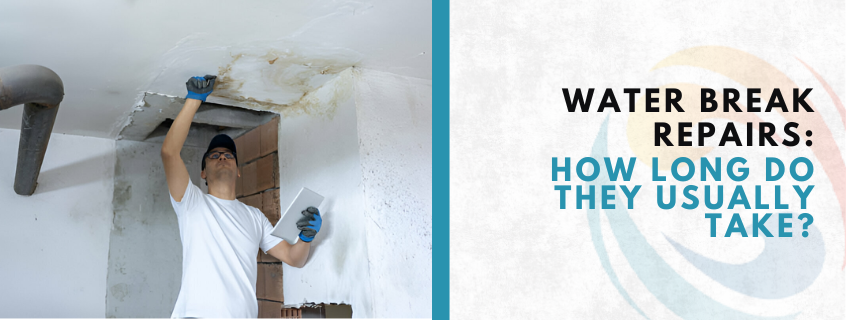
When you hear the word “water break,” what comes to mind? For many, it might evoke images of broken pipes flooding homes or business establishments, creating endless headaches. At 770 Water Damage & Restoration, we know firsthand how stressful these situations can be. That’s why we want to shed light on water break repairs and share insights on how long these repairs typically take, ensuring you’re informed before disaster strikes.
Imagine you wake up one sunny morning and step into your kitchen, only to find water pooling on the floor. Panic ensues. It’s an all-too-common scenario. Water breaks can happen unexpectedly due to various reasons: aging pipes, extreme weather, or even ground shifts. Regardless of the cause, understanding the timeline of repairs can help you prepare and respond effectively.
If you notice any signs of water damage on streets or sidewalks, it’s crucial to report a water main break as soon as possible. When water mains break, they can disrupt essential services and pose safety hazards to the community. Prompt action ensures that the appropriate water main break repair service can respond quickly to minimize damage and restore normal operations. Remember, the sooner you break report a water main, the faster it can be contained and resolved.
The Basics of Water Break Repairs
Water break repairs begin with identifying the issue. This initial step is crucial, as it determines how fast your home can return to normal. Let’s discuss the typical process to handle water breaks, and how long each stage might take.
- Assessment (1-2 hours):
- A professional will arrive to assess the damage. This includes inspecting affected areas to determine the source and the extent of the break.
- Factors considered might include the location of the break, how long the water has been leaking, and the resulting damage.
- Planning (1-3 hours):
- After assessment, the team will outline a repair plan. They’ll discuss options with you and explain the necessary steps.
- This phase helps set clear expectations and timelines.
- Execution of Repairs (4-12 hours or more):
- Depending on the severity, this can vary widely. A simple pipe replacement may take just a few hours, while extensive water damage might extend beyond a day or two.
- Shut off water supply: Ensuring no more water is leaking into your home.
- Replace or repair pipes: Depending on the type of damage, this could involve patching, replacing, or rerouting pipes.
- Water extraction: For broken pipes that have flooded areas, professionals will use pumps to remove excess water.
- Drying and dehumidification: To prevent mold, drying can take 1-3 days, depending on equipment.
- Final Inspection and Clean-Up (1-2 hours):
- Once repairs are completed, a technician will ensure everything is functioning properly and that the area is clean.
The above times are estimates; every situation is unique. Some repairs might be expedited, while others may face delays due to unforeseen issues.
Real-World Scenario: A Day in the Life of Water Break Repairs
To better illustrate this, consider the story of the Miller family. One afternoon, they returned home from a short trip to find their basement flooded. A pipe had burst! They called 770 Water Damage & Restoration, and within an hour, a technician was onsite. After assessing the damage, the technician estimated a repair time of about six hours.
The assessment revealed:
- A burst pipe behind a wall.
- Water had seeped into the carpet and drywall.
Post-assessment, the technicians brought in specialized gear to extract water, allowing them to begin repairs the same day. They replaced the damaged pipe and set up dehumidifiers to ensure proper drying. By evening, the Miller family was back to normal, minus a little disruption and worry.
Key Factors Affecting Repair Time
The duration for water break repairs can depend on several variables:
- Severity of the Damage: A minor leak may take only a few hours to repair, while extensive damage could take several days.
- Location of the Break: If it’s in a hard-to-reach area, repairs will take longer.
- Availability of Parts: Sometimes delays occur due to the need for specific pipe fittings or other supplies that may not be readily available.
- Weather Conditions: Bad weather can impede work progress, especially if the team requires outdoor access.
Preventing Future Water Breaks
While repairs are essential, prevention is critical too. Here are some DIY tips for avoiding future water breaks:
- Regular Inspections: Check pipes at least once a year for signs of wear, such as rust or leaks.
- Insulation: Insulating pipes, particularly in colder climates, can prevent freezing and breaking.
- Know Your System: Understanding your plumbing system’s age and history can alert you to potential problem areas.
Conclusion: Knowing When to Call for Help
Water break repairs can be a hassle, but knowing what to expect can significantly ease your worries. With professionals like 770 Water Damage & Restoration, you can trust that repairs will be handled efficiently, minimizing disruptions to your life. Remember, the quicker you act, the better your chances of preventing serious damage.
Whether you face minor leaks or severe waterbreaks, understanding the timeline and process of repairs will empower you to take action. Don’t be afraid to reach out to professionals for help; they are trained to handle emergencies effectively and can ensure your property is restored safely.
Navigating Through Water Damage Situations
Let’s delve deeper into why prompt attention to water breaks is crucial. Water is often regarded as one of the most damaging elements to a home. If left unaddressed, it can lead to extensive structural damage, mold growth, and costly repairs.
The Risks of Delayed Repairs
- Mold Growth: Within just 24-48 hours, mold can start to grow in damp conditions. This poses health risks and can lead to major expenses if remediation becomes necessary.
- Structural Damage: Prolonged exposure to water can weaken walls, floors, and foundations, leading to expensive repairs or replacements.
- Increased Repair Costs: The longer you wait, the more extensive the damage can become. This often results in higher costs for repairs and restoration.
Steps to Take After a Water Break Incident
- Ensure Safety First: Before anything else, make sure the area is safe. Turn off the electricity if water has reached electrical outlets.
- Document the Damage: Take photos of the affected areas, as this can help with insurance claims later.
- Contact Your Insurance Company: Report the incident to ensure you understand what is covered under your policy.
- Reach Out to Professionals: Engage with water damage restoration experts immediately for a thorough assessment and repair.
Choosing the Right Restoration Company
Not all restoration companies are created equal. When looking for help, consider the following:
- Experience: Ensure the company has a solid track record in handling water damage repairs.
- Certification: Check for industry certifications (like those from the Institute of Inspection, Cleaning and Restoration Certification—IICRC).
- Insurance: Verify that the company is fully insured to protect against any liabilities during the repair process.
- Customer Reviews: Look for feedback from previous clients to gauge reliability and service quality.
Conclusion: A Proactive Approach to Water Damage
In the end, understanding how long water break repairs typically take equips homeowners and DIY enthusiasts with knowledge to navigate potential crises effectively. By acting swiftly and knowing what to expect, you can minimize the damage and get your home back in order.
At 770 Water Damage & Restoration, we pride ourselves on our swift response times and expertise in water break repairs. Remember, while you can take steps to prevent issues, emergencies can still arise. Being prepared and informed can make all the difference when an unexpected crisis occurs. If you find yourself dealing with water damage, don’t hesitate to reach out. We’re here to help ensure you get the support you need to restore your home to its original condition.
By following these guidelines and keeping an eye on your plumbing, you can help protect your home from the potentially disastrous impacts of water breaks. Your safety and comfort are paramount, and understanding water break repairs is a crucial part of being a responsible homeowner. Stay informed and proactive, and you’ll be prepared when the unexpected happens.
In summary, managing water break repairs effectively hinges on swift action, understanding the repair process, and relying on professional expertise. By being proactive and maintaining your plumbing system, you can reduce the risk of experiencing water breaks and ensure a safe, comfortable space for you and your loved ones.
Top Questions Answered About Water Breaks and Home Protection
How can I tell if I have a water break in my home?
Signs of a water break can include unexplained damp spots on walls or ceilings, unusual increases in your water bill, the sound of running water when all faucets are off, or pooling water on your floors. If you suspect a water break, contact 770 Water Damage & Restoration immediately for a comprehensive assessment and prompt repairs.
2. What should I do immediately after discovering a water break?
First, ensure that you and your family are safe. Turn off the main water supply to prevent further damage. Avoid electrical outlets or devices that may have come into contact with water. Next, contact 770 Water Damage & Restoration to assess the damage and begin the repair process as quickly as possible.
3. How long do water break repairs typically take?
The time required for water break repairs can vary based on the severity of the damage, but generally, assessment and immediate repairs can take anywhere from a few hours to several days. At 770 Water Damage & Restoration, our skilled team works efficiently to minimize downtime and restore your home promptly.
4. Will my homeowners’ insurance cover water break repairs?
Many homeowners’ insurance policies cover damages caused by water breaks, but it often depends on the specifics of your policy. It’s important to report the incident to your insurance company and document the damage. The experts at 770 Water Damage & Restoration can provide you with detailed reports and photos to assist in the claims process.
5. How can I prevent future water breaks in my home?
Preventative measures include regularly checking and maintaining your plumbing, insulating exposed pipes, and being aware of changes in water pressure. Ensuring that your systems are in good condition can significantly reduce the risk of water breaks. For professional advice and preventative maintenance services, reach out to 770 Water Damage & Restoration.


